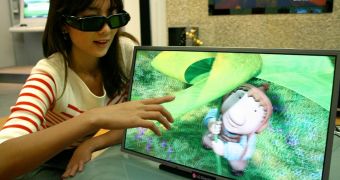Although 3D imaging has already been implemented in certain video games, movies and animations, the IT market did not have, until now, any display products capable of rendering 3D effects in Full-HD resolution. After a long wait, all types of users will finally be able to get their hands on a display capable of rendering those true-to-life, 3D images they have been yearning for, a performance that the other, non-HD displays currently selling are incapable of.
The monitor can deliver a video quality that is twice as sharp as that of other 3D-capable displays. This performance is achieved by means of the company's proprietary “high performance 3D exclusive controller” technology, which can process over two times more data than other HD 3D LCDs. In addition, the “copper bus line” improves resolutions and the overall picture quality. Naturally, the monitor is not confined to 3D alone, having the ability to switch between 2D and 3D modes.
“LG Display has made a major breakthrough in the display industry race to deliver the depth and dynamic nature of 3D images,” LG Display's Vice President and head of IT marketing department, Mr. Davis Lee, noted. “LG Display will continue with efforts to keep pace with the fast growing 3D market with leading 3D technology and products in order to create new value for customers.”
LG may have done its best to introduce this product as soon as possible as a response to the fact that the Korea Communications Commission announced its plans to launch a trial phase of the world's first Full-HD 3D terrestrial broadcasting. Japan and the UK also intend to start trial services for 3D satellite broadcasting. This new monitor will be a suitable means of enjoyment of these broadcasts and, along with the products that will emerge in its wake, will provide a basis for the more rapid growth of 3D software, films and games.

 14 DAY TRIAL //
14 DAY TRIAL //